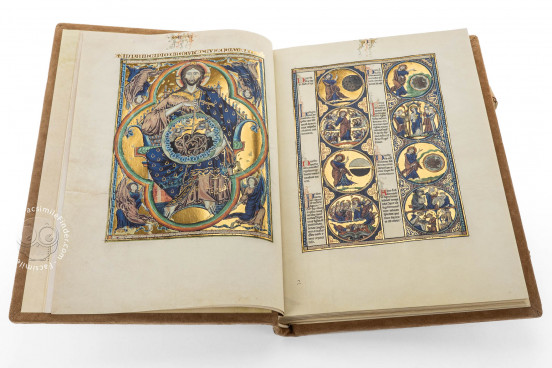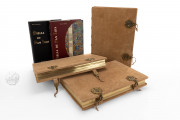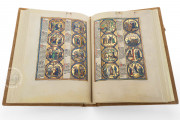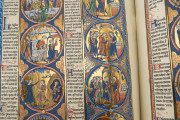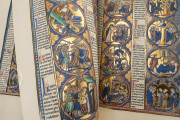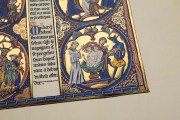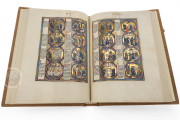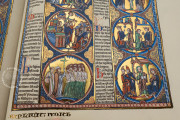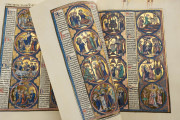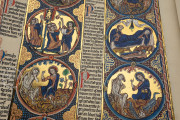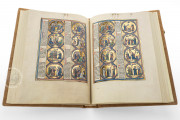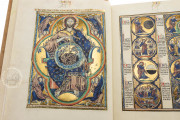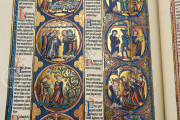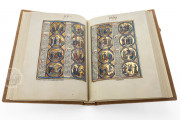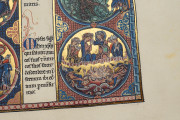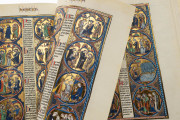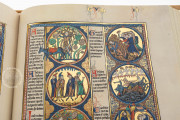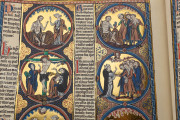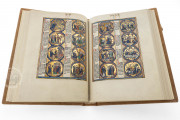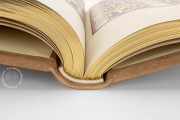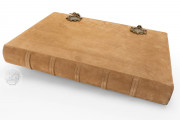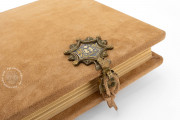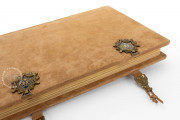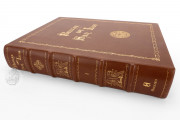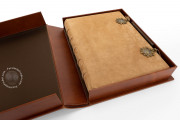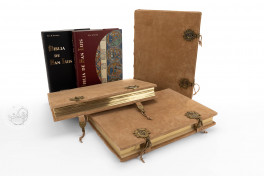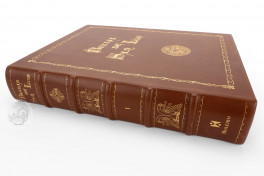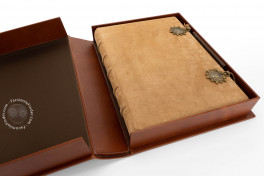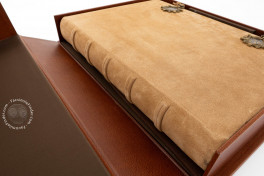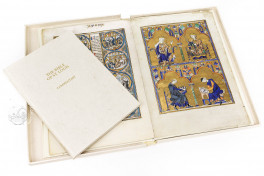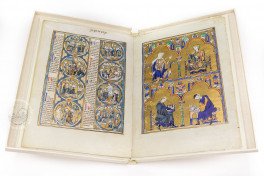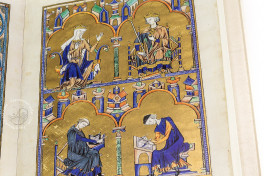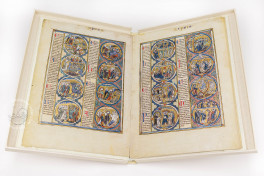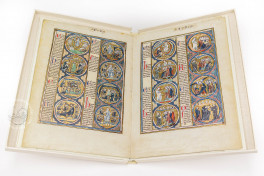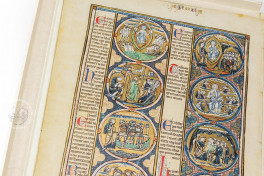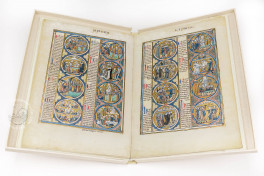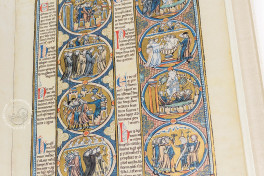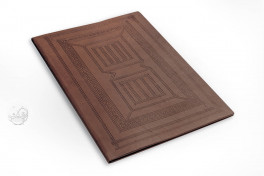Made in Paris at the behest of Blanche of Castile, Queen of France, for her son Louis IX, King of France, the Bible of Saint Louis—also known as the Biblia Rica—is a three-volume moralized Bible (Bible moralisée), a picture book of biblical stories and their understanding in terms of Christian history and doctrine. Blanche commissioned the mammoth undertaking between 1226 and 1234, perhaps—even probably—to mark the young Louis's marriage to Marguerite of Provence in 1234. Its nearly 5,000 vignettes chronicle Jewish and Christian history and thirteenth-century interpretations of that history. It concludes with a full-page dedication miniature.
The Bible's large painted pages feature dazzling burnished and tooled gold leaf. The palette, typical of Parisian painting of the time, is dominated by red and deep blue. The palette and the arrangement of the scenes into roundels give the pages the appearance of contemporary stained glass windows.
Moralizing the Bible
The manuscript's leaves are painted on one side only so that a blank opening follows each fully painted opening of two facing pages. The vignettes are arranged in two columns of four roundels to be read from top to bottom and left to right, with each biblical scene followed by its "moralization." For example, the vignette showing David hiding from Saul in a cave (as described in I Kings) is paired with a moralization explaining that David signifies monks and hermits who live in community (Toledo, MS 1, fol. 111v).
Two Generations of Illuminators
A team of artists created the imagery of the Bible of Saint Louis. Work began with volume 3 by at least two artists involved in creating two earlier moralized Bibles for French royalty (Vienna Bible Moralisée in French and Vienna, Österreichische Nationalbibliothek, Cod. 1179). Two other artists, working with assistants, started to fill in or assist the veterans until (by fol. 81) the younger artists took over the work and then continued with volumes 1 and 2.
Texts in Latin and French
The text, which takes the form of a series of picture captions, is written in Gothic Textualis. It is much abbreviated because of space restrictions and the formulaic nature of the moralizations. Each caption opens with a pen-flourished initial, alternating blue with red flourishing and red with blue flourishing.
The captions of volumes 1 and 2 are in Latin. In parts of volume 3, additional captions in French are included. Many of the Latin texts of the first half of volume 3 have been written over erasures, and the French-language texts appear only up to fol. 81 in volume 3.
The Making of a Moralized Bible Depicted
The Bible of Saint Louis is justly famous for its dedication miniature (New York, MS M.240, fol. 8r), which shows Blanche and Louis above and two more figures below within an elaborate architectural framework against a shimmering tooled gold background. At the bottom left a cleric, his hand pointing in a gesture of instruction, represents the person(s) behind the manuscript's theological content. Opposite him, a lay craftsman is shown in the act of designing a page of the book.
A Cathedral Treasure since the Thirteenth Century
Louis gave the three-volume work to Alfonso X "the wise" (1221-1284), King of Castile and Leon, who kept it at Toledo. Volume 1 is missing thirty-three of its original leaves, all certainly gone before the eighteenth century. The last gathering of eight leaves of volume 3 was estranged from the rest of the volume by the fifteenth century. It passed through many hands before being purchased by J. Pierpont Morgan (1837-1913) in 1906. Morgan's son, J. P. Morgan (1867-1943), made his father's collection a public institution in 1924 (now the Morgan Library & Museum).
The present bindings of the codices in Toledo, which date from the eighteenth century, are of white leather covered with red velvet and feature silver clasps reused from an earlier binding. The clasps, which date from the sixteenth century, show the coat of arms of Saint Louis (1274-1297), Bishop of Toulouse, at that time believed to have once owned the Bible. The present binding of the fragment in New York dates from around 1500.
We have 3 facsimiles of the manuscript "Bible of Saint Louis":
- Biblia de San Luis facsimile edition published by M. Moleiro Editor, 2000-2004
- Die Bibel Ludwigs des Heiligen (Standard Edition) facsimile edition published by Akademische Druck- u. Verlagsanstalt (ADEVA), 1995-1996
- Die Bibel Ludwigs des Heiligen (Real Gold Edition) facsimile edition published by Akademische Druck- u. Verlagsanstalt (ADEVA), 1995-1996

